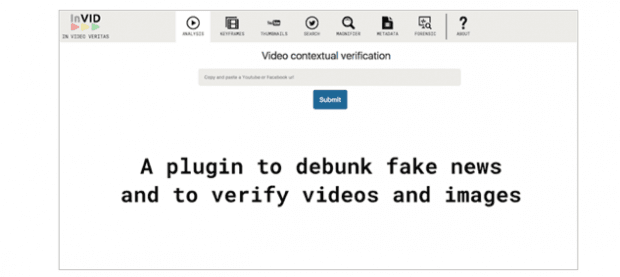Supporting Video Verification With InVID
,The InVID research project releases a plug-in that supports journalists in verifying videos
One of the research projects in which we are involved is InVID–'In Video Veritas'. The project, running from 2016 until the end of 2018, deals with various aspects of video verification. This includes investigating legal aspects, supporting rights clearance processes, and above all the development and testing of tools and modules that support and part-automate the verification of videos.
Half-way into the project's duration, the project is pleased that first results can be made available to the public and, in particular, the verification community.
One of the research projects in which we are involved is InVID–'In Video Veritas'. The project, running from 2016 until the end of 2018, deals with various aspects of video verification. This includes investigating legal aspects, supporting rights clearance processes, and above all the development and testing of tools and modules that support and part-automate the verification of videos.
Half-way into the project's duration, the project is pleased that first results can be made available to the public and, in particular, the verification community.Verification plug-in released to public
Under the leadership of Denis Teyssou of French news agency AFP's innovation lab, a plug-in was developed for both the Chrome and Firefox browsers. It brings together a number of formerly separate verification activities into one single application, adding components and features such as modules that are being developed in InVID, as well as third party tools.
Features of the plug-in
The plug-in includes a number of features, such as
- provision of contextual information on YouTube and Facebook videos;
- fragmentation of videos from several platforms (Facebook, Instagram, YouTube, Twitter, Daily Motion) into key frames;
- query of reverse image search engines such as Google, Yandex and Baidu;
- magnifying of pictures and / or key frames to see individual image components / parts thereof in greater detail;
- provision of metadata information;
- use of forensic filters to detect alterations of an image;
- search of Twitter posts in a more effective way, by providing the opportunity to define a time range 'up to the exact minute', and the application of other filters.
Reception by the verification community
The project team is very pleased that the InVID verification plug-in has been well received by the verification community. This ranges from contributions in the trade press (see for example the article "InVID Wants to Help Journalists Debunk Fake Videos" in MediaShift.org) to very positive comments on Twitter (see InVID's Twitter channel, especially the period early July to early August 2017, in which some of these comments have been re-tweeted).
In particular, the project team was delighted about a tweet by one of the project's reviewers, Sam Dubberley. Sam, who is a renown verification expert (e.g. through his involvement in First Draft News, Eyewitness Media Hub and Amnesty International's Digital Verification Corps) tweeted the following on 21 July 2017, when he was tasked with the verification of numerous videos:
Nothing much to add! 🙂
Links and resources
- The beta version of the plug-in for Chrome is available for Windows, Mac OS X and Linux users at https://goo.gl/Fo8i73. To install it, simply click on "Add to Chrome". If you want to update any previously installed version of the plug-in, go to the extensions-page in chrome (type chrome://extensions in your browser), check the "developer mode" box on the top right (make sure it is ticked) and then click on the button called "update extensions now" (also on the top right)
- A beta version of the plug-in for Firefox is available for Windows, Mac OS X and Linux To install (or to update any previously installed version), you need to download the respective zip file, unpack it, and then drag and drop the created XPI file into a new tab of your Firefox browser.
- A video tutorial and demo that outlines all the features of the plug-in is available on InVID's YouTube channel.
- There's more textual information on the project website, where the main features of the toolkit are explained, too.
- The plug-in code (identical for Firefox and Chrome) is publicly available on GitHub as open source under an MIT licence.
- Should you have any feedback, especially suggestions for improvements or change requests, the InVID project team would very much appreciate your comments. The contact e-mail for anything dealing with the plug-in is invid-verification-plugin@iti.gr.
- Note: There will be updates and improvements in due course. At the time of writing this article (7 August 2017) version 0.55 (release date: 4 August 2017) has been available.
- More information about all sorts of aspects of the project is available on the InVID website.
Disclaimer
And finally, a disclaimer: the software linked to above and developed by the InVID project team is provided "as is", without warranty of any kind, expressed or implied, including–but not limited to–the warranties of merchantability, fitness for a particular purpose and non-infringement. In no event shall the authors or copyright holders be liable for any claim, damages or other liability, whether in an action of contract, tort or otherwise, arising from, out of or in connection with the software or the use or other dealings in the software.
